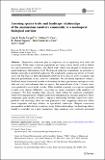| dc.description.abstract | Mammalian carnivores play an important role in regulating food webs and ecosystems. While many carnivore populations are facing various threats such as habitat loss and fragmentation, poaching, and illegal trade, others have adapted to human-dominated landscapes. Information about Neotropical carnivore communities in particular is limited, especially in disturbed landscapes. We conducted a camera trap survey at 38 sites across the San Juan–La Selva Biological Corridor in Costa Rica to assess occupancy and detection probabilities of the carnivore community. We developed hypotheses within a likelihood-based framework in order to determine the landscape features and species traits (diet and size) that influenced their occupancy. We detected nine of the 13 native carnivores predicted to occur in the corridor. When modeled separately, each species responded to land cover changes differently, suggesting no strong community-wide predictors of occupancy. We then modeled three separate guilds within the carnivore community: omnivorous mesopredators, obligate carnivorous mesopredators, and apex predators. These community guild models revealed a negative relationship between omnivorous mesopredators and increasing forest and tree plantation cover, suggesting omnivores utilize forest fragments and edge habitats in agricultural landscapes. Obligate carnivorous mesopredator models did not reveal any strong habitat relationships, but landscape effects tended to contradict our a priori predictions. Apex predators were positively associated with increasing forest and tree plantation cover, protected areas, and increasing distances to villages. Alarmingly, apex predators and obligate carnivorous mesopredators were generally rare within the biological corridor. A lack of top-down control alone might result in heightened occupancy for all mesopredators, but because the community is dominated by omnivorous species, bottom-up release from human-induced land cover changes and resource provision may better explain their high occupancy. © 2016, Springer Science+Business Media Dordrecht. | es_ES |

